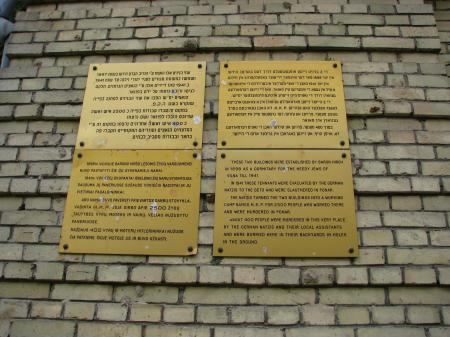Obj. ID: 46025
Jewish Architecture Plaque on the Cheap Houses in Vilnius, Lithuania, 1993
To the main object: Cheap Houses in Vilnius, Lithuania

Who is Commemorated?
The Jewish occupants of the Cheap Houses and the Jewish workers of the HKP forced labor camp.
Description:
Four metal plaques with inscriptions in Yiddish, Hebrew, Lithuanian, and English are placed on the eastern façade of the western building (47 Subačiaus St.).
Inscriptions:
In Yiddish:
די 2 בנינים זיינען אופגעשטעלט דורך דעם באראָן הירש
אין יאר 1898 פאר דער ארעמער יידישער באפעלקערונג אין ווילנע.
אין יאר 1941 האבן די נאצי-מערדער איבערזידלט די איינוואינער
אַ טייל אין געטא, די איבעריקע קיין פאנאר, וואו זיי זיינען דערמארדעט
געווארן דורך די נאציס מיט זייערע ארטיגע מיטהילפער ימ"ש.
די 2 הייזער זיינען פארוואנדלט געווארן אין אַ צוואנגס ארבייטס
לאגער וועלכיר האט גיהייסן H.K.P., דא האבן געארבעט בערך
2500 מענער, פרויען און קינדער, דער גרעסטער טייל איז דערמארדעט
געווארן אי פאנאר.
בערך 400 מענער, פרויען און קינדער האבן די נאציס דערמארדעט
דא, אויפן הויף, און זיינען באגראבן אין גריבער ארום די הייזער.
In Hebrew:
שני בנינים אלו הוקמו ע"י הנדיב הבַרון הירש בשנת 1897
ושמשו כמעונות מגורים לעניי יהודי וילנה עד שנת 1941.
ב1941 פונו דיירים אלה ע"י הנאצים הגרמנים, חלקם
לגיטו ורובם נרצחו על ידם בפונאר.
הנצים ימ"ש הפנו את שני הבנינים למחנה כפייה
שנקרא בשם ה.ק.פ.
במקום זה עבדו עבודות כפייה כ 2500 איש ואשה
שרובם הובלו לפונאר ושם נרצחו.
כ 400 איש ואשה אחרונים נרצחו במקום זה ע"י
המרצחים הנאצים ועוזריהם המקומיים ונקברו פה
בחצר ובבורות מסביב לבתים.
In Lithuanian:
1898m. Vilniuje Barono Hiršo lėšomis žydų varguomenei
buvo pastatyti šie du gyvenamieji namai.
1941m. vokiečių okupantai iškeldino šių namų gyventojus.
Dauguma [Daugumą] jų Paneriuose sušaude [sušaudė] vokiečiu [vokiečių] nacistai ir jų
vietiniai pagalbininkai.
Abu namai buvo paversti prievartos darbų stovykla,
vadinta H.K.P. Joje dirbo apie 2500 žydų
tautybės vyrų, moterų ir vaikų, vėliau nužudytu [nužudytų]
Paneriuose.
Maždaug 400 vyrų ir moterų hitlerininkai nužudė
čia patkieme [pat kieme]. Šioje vietoje jie ir buvo užkasti.
In English:
These two buildings were established by Baron Hirch [Hirsch]
in 1898 as a dormitary [dormitory] for the needy Jews of
Vilna till 1941.
In 1941 these tennants [tenants] were evacuated by the German
Natzis [Nazis] to the geto [ghetto] and were slauthered [slaughtered] in Ponar.
The Natzis [Nazis] turned the two buildings into a working
camp named H.K.P. for 2500 people who worked there
and were murdered in Ponar.
About 400 people were murdered in the very place
by the German Natzis [Nazis] and their local assistants
and were burried [buried] here in their backyards in holes
in the ground.
Commissioned by
Yeshayahu (Shaya) Epstein
sub-set tree:
The Cheap Houses were built in 1897-1898 in order to provide affordable and hygienic housing for poor Vilnius Jews.
With the German occupation in 1941, their Jewish dwellers were driven to their murders in Ponary or resettled in the ghetto. The two buildings were converted into a camp for the wives and children of Red Army officers who stayed in the city when the Red Army retreated. By the autumn of 1943, some women had been killed in Ponary and others sent for forced labor in Germany, while the children were sent to orphanages. A plaque in memory of those women and children was affixed to the eastern building (49 Subačiaus St.) in the early 2000s.
In late August and early September 1943, the buildings were converted into an army vehicles repair shop known as The HKP (Heereskraftfahrpark Ost 562), and a labor camp for Jews working there. The idea to create a separate camp for Jewish workers was came from Major Karl Plagge, a German Officer and the head of HKP (he would later be named as one of the Righteous Among the Nations in 2004). After the annihilation of the ghetto, the camp also housed wives, children, and sometimes parents of the workers. In November 1943, there were 1,218 registered inmates and in March 1944 there were 1,257.
On March 27, 1944, a children’s Aktion was conducted, during which all children under the age of 16 were seized. According to some sources, the children were transferred to death camps in Poland, according to others they were killed in Vilnius and buried in the Third Jewish cemetery.
On July 1, 1944, Plagge announced that the HKP was being relocated because of the approaching Red Army and indirectly warned the prisoners about a planned murder. On July 3, 1944, those who were not hiding were sent to Ponary. On July 4, 1944, SS men undertook a search of the building, and the around 200 discovered Jews were shot immediately near the buildings. On July 9, the Red Army arrived to the camp and those who had not been found – about 150-200 people – were set free.
After the war, the buildings were used by the Soviets as a camp for German POWs.
The plaques were fixed in connection of the unveiling of two nearby monuments on July 13, 1993.
Agranovskii, Genrikh. Oni zdes’ zhili... Zametki o evreiskom nasledii Vilniusa (Vilnius: Versus Aureus, 2014)., 197-201.
Guzenberg, Irina, Vilnius: Sites of Jewish Memory. A Concise Guide. Second revised and supplemented edition. Trans. Svetlana Shatalova (Vilnius: Pavilniai Publishers, 2019)., 62-63.
Guzenberg, Irina, Vilnius: Traces of the Jewish Jerusalem of Lithuania. Memorable Sites of Jewish History and Culture. A Guidebook (Vilnius: Pavilniai, 2021)., 594-602.
Guzenberg, Irina, Žydų darbo stovykla HKP, 1943–1944: Dokumentai – Еврейский рабочий лагерь Х.К.П., 1943–1944: Документы – The H.K.P. Jewish Labor Camp, 1943–1944: Documents (Vilnius: The Vilna Gaon Jewish State Museum, 2002).
Guzenberg, Irina. Vilnius: Pamiatnye mesta evreiskoi istorii i kul'tury (Vilnius: Pavilniai, 2013)., 60.
Holocaust Atlas of Lithuania, THE HKP JEWISH LABOR CAMP,., http://www.holocaustatlas.lt/EN/ (accessed December 20, 2022)
Itzhak Alfasi (ed.), Vilna yerushalayim de-lita hareva! haita ve-einena od (Tel Aviv, 1993), 24-27.
Jakulytė-Vasil, Milda. Lithuanian Holocaust Atlas (Vilnius: VIlna Gaon State Jewish Museum, 2011), 298-299.
Levinson, Yosif, Skausmo knyga. The Book of Sorrow. Dos bukh fun veytik. Sefer ha-keev (Vilnius: VAGA Publishers, 1997)., 48-49.



